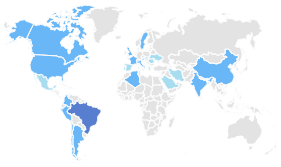Guanabara Bay: For all hopes to a new awakening of paradise
Resumo
Abstract: Exclusion Territories are geographical areas under the action of degenerative environmental phenomena of anthropogenic origin, which compromise quality of life in general. One of the greatest examples of such areas is the Guanabara Bay and its surroundings, the scene of some of the worst disastrous incidents and locale of frequent episodes of human misery. This article presents a brief description of the main characteristics of the region, providing some technological suggestions of biogeographic recovery to be adopted by public policies that intend to align themselves with the good practices of ecological economy, sustainability and quality of life. The work falls within the context of macro-engineering cum eco-innovation applied to the preservation and management of water sources and water bodies that serve productive purposes as natural niches and breeding grounds.
Key words: Exclusion Territories, Guanabara Bay, waste management, quality of life.
===================================================================
Resumo: Territórios de Exclusão são áreas geográficas sob ação de fenômenos ambientais degenerativos de origem antropogênica, os quais comprometem a qualidade de vida em geral. Um dos maiores exemplos de zonas desse tipo é a Baía de Guanabara e seu entorno, palco de alguns dos piores incidentes desastrosos e de frequentes episódios da miséria humana. O presente artigo descreve sumariamente as principais características da região, fornecendo algumas sugestões tecnológicas de recuperação biogeográfica a serem adotadas por políticas públicas que pretendam alinhar-se às boas práticas de economia ecológica, sustentabilidade e qualidade de vida. O trabalho se insere no contexto da macroengenharia cum eco-inovação aplicada à preservação e à gestão das fontes hídricas e dos corpos de água que servem a propósitos produtivos como nichos naturais e criadouros.
Palavras-chave: Territórios de Exclusão, Baía de Guanabara, gestão de resíduos, qualidade de vida.
===================================================================
Abstrakt: Ausschlussgebiete sind geografische Regionen, in denen degenerative Umweltphänomene anthropogenen Ursprungs auftreten, die im Allgemeinen die Lebensqualität beeinträchtigen. Eines der besten Beispiele für solche Gebiete ist die Guanabara-Bucht und die Umgebung, Schauplatz einiger der schlimmsten katastrophalen Vorfälle und Schauplatz häufiger Episoden menschlichen Elends. Dieser Artikel enthält eine kurze Beschreibung der Hauptmerkmale der Region sowie einige technologische Vorschläge für die biogeografische Erholung, die die öffentliche Politik zur Angleichung an bewährte Praktiken in Bezug auf ökologische Ökonomie, Nachhaltigkeit und Lebensqualität annehmen sollte. Die Arbeit fällt in den Kontext von Makrotechnik und Öko-Innovation, die auf die Erhaltung und Bewirtschaftung von Wasserquellen und Gewässern angewendet werden, die als natürliche Nischen und Brutstätten für produktive Zwecke dienen.
Schlüsselwörter: Ausschlussgebiete, Guanabara-Bucht, Abfallwirtschaft, Lebensqualität.
Texto completo:
PDFReferências
Paul, S. et al. (16 May 2018) “Moisture Supply From the Western Ghats Forests to Water Deficit East Coast of India” Geophysical Research Letters 45: 4337-4344.
Srivalli, C.N.S. et al. (March 2019) “Complexity of stream flows in the west-flowing rivers of India” Stochastic Environmental Research and Risk Management 44: 837-853.
Serpa, N. and Cathcart, R.B. (March 2019) “Guanabara Bay: Proposals for a Territory of Exclusion Born from Paradise—Part I, The Present-Day Mess” Revista Brasiliense de Engenharia e FisicaAplicada4: 1-11. SEE: Serpa, N. and Cathcart, R.B. (December 2019) “Proposals for a Territory of Exclusion Born from Paradise—Part II, For a Macro-Engineering Covenant” Revista Brasiliense de Engenharia 3 FisicaAplicada 4: 19-27.
Mauad, C.R. et al. (2015) “Urban rivers as conveyors of hydrocarbons to sediments of estuarine areas: Source characterizations, flow rates and mass accumulation” Science of the Total Environment 506-607: 656-666.
Benoit, R.G. et al. (2019) “Forming attitudes via neural activity supporting affective episodic simulations” Nature Communications 10: 2215.
Hughes, A. (2013) “A new type of urban form? Possible futures for fabric structures in urban contexts”. Journal of Urbanism: International Research on Placemaking and Urban Sustainability 6: 302-306.
Balasubrahmanyam, S.N. (10 June 2017) “Captive wind power for transfer of water across the Western Ghats, India” Current Science 112: 2176.
Paul, S. et al. (16 May 2018) “Moisture Supply From the Western Ghats Forests to Water Deficit East Coast of India” Geophysical Research Letters 45: 4337-4344.
Valdez, B. et al. (2010) “Effect of climate change on durability of engineering materials in hydraulic infrastructure: an overview” Corrosion Engineering Science and Technology 45: 34.
Schorr, M. et al. (2012) “Water pipelines and blood vessels: a comparison of hard and soft materials” Journal of Materials Education 34: 59-68.
Van Meter, K.J. et al. (27 February 2014) “Monsoon harvests: The Living Legacies of Rainwater Harvesting Systems in South India” Environmental Science & Technology 48: 4217-4225.
Cathcart, R.B. (25 August 2003) “Palk Strait power station: A future fixed link on Adam’s Bridge?” Current Science 85: 430431.
Cathcart, R.B. (25 April 2005) “Nautical jugs or not?” Current Science 88: 1211-1212.
Cathcart, R.B. (December 2018) “Solar Thermal-powered Desalination Fountain-Barge: Macro-Imagineering NE Venezuela’s Golfo de Cariaco”Revista Brasiliense de Engerharia e FisicoAplicado 3: 10-19.
Donaldson, D. (April 2018) “Railroads of the Raj: Estimating the Impact of Transportation Infrastructure” American Economic Review 108: 899-934.
DOI: http://dx.doi.org/10.17648/calibre.v5i1.979
Apontamentos
- Não há apontamentos.
Direitos autorais 2020 Nilo Serpa, Richard Cathcart
Indexadores, Diretórios, Bases de Dados e Registros (Abstracted and Indexed in):

CALIBRE - Revista Brasiliense de Engenharia e Física Aplicada
ISSN Eletrônico: 2526-4192































